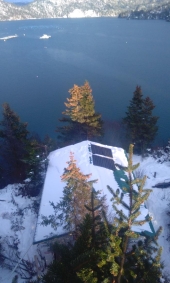posted 12 years ago
Eric :I am still a Newb at Aqua-p, but,Let me take a stab at the Rocket Mass HeaterR.M.H. program, depending on how you were taught to 'run' a greenhouse,
And at certain times of the Year Moisture will be a major issue for your R.M.H., It needs frequent feedings of Small fine split very dry wood to perform at the
very efficient levels it is capable of burning at.
R.M.H.s don't need a lot of attention, but do need frequent attention, so you have a need for the Rocket to be co-located in a very centralized location to see
that it is performing well, and You need to store your Rocket heaters wood outside of the Greenhouse, with a pass-through arrangement to not be trying to
carry in arm loads of wood and be unable to close the greenhouse door at -15F !
Bricks,High Temperature fire bricks, a pale shade of baby shit yellow are preferred,because they insulate the Combustion Chamber/Burn Tunnel, Reflecting
the heat back into the combustion area and Quickly raise the internal temperatures that create the high temp clean burn that R.M.H.s are famous for, Soft
Smooth faced building brick usually an red but kinda orange-ish too, has a long history in being recycled from hundred year old buildings,( and not the harder
sometimes darker red, with exterior scribing) And used directly as stacked and thin mortared parts of the Feed Tube, Burn Tunnel, and as the Heat Riser.
With any heat riser made out of any brick there is a major gain to be made by Insulating around the outside of the Heat Riser with Perlite and Clay Slip, or
Rock wool ! Heat Risers can be made up with 'stove pipe' on the inside and the outside as forms and filled with at least 2'' of a clay slip/perlite mix,
You should consider all your stove pipe to be sacrificial, You can not use metal in the combustion chamber, and in the Heat Riser area you can only use pipeing
as forms for the perlite and clay slip that will burn up in everyday Use leaving the Clay slip and perlite behind as a semi permanent Heat Riser! This is pot a
negative, the 5+ years you should be able to achieve should see you through to a much superior Aftermarket D.I.Y. replacement !
Please go to the Rocket Stoves Forum/Thread " Rocket Mass Heater: Duct burns'' for a discussion on Galvanized pipe And then go to our sister site richsoil.com
and click on the link to Rocket stoves on the home page, this will take you to a set of videos to show you how to prepare your barrel and 1st 4'- 5'of stove pipe
All the remaining galvanizing left on the stove pipe after your Burn has undergone a change in the way it is locked to the pipe and will not outgas more- after the
1st 4' - 5' your standard galvanizing should never get warm enough to be a problem !Hope this helps and was timely ! For the good of the Craft .
As always, your questions and comments are solicited and Welcome ! Think like fire Flow like gas, Don't be the Marshmallow ! PYRO - Logically BIG AL !
Success has a Thousand Fathers , Failure is an Orphan
LOOK AT THE " SIMILAR THREADS " BELOW !









 GL on your venture
GL on your venture















.jpg)




